Effect of Grain Size on Dynamic Compression Behavior and Deformation Mechanism of ZK60 Magnesium Alloy
Abstract
:1. Introduction
2. Experimental Material and Method
3. Results and Discussion
3.1. Initial Microstructure of ZK60 Alloys with Different Grain Sizes
3.2. Mechanical Response of ZK60 Alloys with Different Grain Sizes
3.3. Microstructure Evolution of ZK60 Alloys with Different Grain Sizes
3.4. Distribution Grain Boundaries in ZK60 Alloys with Different Grain Sizes
3.5. Deformation Mechanism of ZK60 Alloys with Different Grain Sizes
3.6. Dislocation Analysis of ZK60 Alloys with Different Grain Sizes
3.7. Constitutive Relation of Dynamic Compression
4. Conclusions
- (1)
- The ZK60 alloy exhibited the decrease in yield strength and peak stress as the grain size increased under dynamic compression.
- (2)
- According to the Schmid factor analysis, the grain refinement in ZK60 alloys was conducive to the activation of basic slip under dynamic compression, so that the main deformation mechanism of alloys transformed from pyramidal <a> slip to {10–12} tensile twinning and pyramidal <a> slip.
- (3)
- The fitting results obtained using the modified J-C constitutive equation were consistent with experimental data, thereby proving the validity of the model proposed for accurate prediction of the deformation of ZK60 alloys with different grain sizes under dynamic compression.
Author Contributions
Funding
Data Availability Statement
Conflicts of Interest
References
- Alvarez-Lopez, M.; Pereda, M.D.; Valle, J.A.; Fernandez-Lorenzo, M.; Garcia-Alonso, M.C.; Ruano, O.A. Corrosion behaviour of AZ31 Mg alloy with different grain sizes in simulated biological fluids. Acta Biomater. 2009, 6, 1763–1771. [Google Scholar] [CrossRef]
- Liu, S.M.; Wei, Z.Q.; Liu, Z.; Mao, P.L.; Wang, F.; Wang, Z.; Zhou, L.; Yin, X.N. Effect of Zn content on hot tearing susceptibility of LPSO enhanced Mg-Znx-Y2-Zr0.06 alloys with different initial mold temperatures. J. Alloys Compd. 2022, 904, 16393. [Google Scholar] [CrossRef]
- Bernard, J.D.; Jordon, J.B.; Lugo, M.; Hughes, J.M.; Rayborn, D.C.; Horstemeyer, M.F. Observations and modeling of the small fatigue crack behavior of an extruded AZ61 Mg alloy. Int. J. Fatigue 2013, 52, 20–29. [Google Scholar] [CrossRef]
- Wei, Z.Q.; Mu, W.P.; Liu, S.M.; Wang, F.; Zhou, L.; Wang, Z.; Mao, P.L.; Liu, Z. Effects of Gd on hot tearing susceptibility of as-cast Mg96.94-Zn1-Y(2−x)-Gdx-Zr0.06 alloys reinforced with LPSO phase. J. Alloys Compd. 2022, 926, 16895. [Google Scholar] [CrossRef]
- Peng, J.H.; Zhang, Z.; Liu, Z.; Li, Y.Z.; Guo, P.; Zhou, W.; Wu, Y.C. The effect of texture and grain size on improving the mechanical properties of Mg-Al-Zn alloys by friction stir processing. Sci. Rep. 2018, 8, 4196. [Google Scholar] [CrossRef]
- Tang, W.R.; Liu, Z.; Liu, S.M.; Zhou, L.; Mao, P.L.; Guo, H.; Sheng, X.F. Deformation mechanism of fine grained Mg-7Gd-5Y-1.2Nd-0.5Zr alloy under high temperature and high-strain-rates. J. Magnes. Alloy. 2020, 8, 1144–1153. [Google Scholar] [CrossRef]
- Zhang, F.; Liu, Z.; Yang, M.M.; Su, G.Y.; Zhao, R.F.; Mao, P.L. Microscopic mechanism exploration and constitutive equation construction for compression characteristics of AZ31-TD Mg alloy at high-strain-rate. Mater. Sci. Eng. A 2019, 771, 138571. [Google Scholar] [CrossRef]
- Lu, L.; Huang, J.W.; Fan, D.; Bie, B.X.; Sun, T.; Fezzaa, K.; Gong, X.L.; Luo, S.N. Anisotropic deformation of extruded Mg alloy AZ31 under uniaxial compression: A study with simultaneous in situ synchrotron X-ray imaging and diffraction. Acta Mater. 2016, 120, 86–94. [Google Scholar] [CrossRef]
- Dai, Y.X.; Xiao, M.H.; Hu, Y.B.; Yang, Y.; Jiang, B.; Zheng, T.X. Effect of extrusion parameters on microstructure and mechanical properties of Mg-0.12Ca-0.08Ba alloy. J. Mater. Res. Technol. 2022, 20, 1570–1579. [Google Scholar] [CrossRef]
- Yang, M.B.; Li, H.L.; Duan, C.Y.; Zhang, J. Effects of minor Ti addition on as-cast microstructure and mechanical properties of Mg-3Sn-2Sr (wt.%) Mg alloy. J. Alloys Compd. 2013, 579, 92–99. [Google Scholar] [CrossRef]
- Lv, C.L.; Liu, T.M.; Liu, D.J.; Jiang, S.; Zeng, W. Effect of heat treatment on tension-compression yield asymmetry of AZ80 Mg alloy. Mater. Des. 2012, 33, 529–533. [Google Scholar] [CrossRef]
- Wang, J.F.; Gao, S.; Song, P.F.; Huang, X.F.; Shi, Z.Z.; Pan, F.S. Effects of phase composition on the mechanical properties and damping capacities of as-extruded Mg-Zn-Y-Zr alloys. J. Alloys Compd. 2011, 509, 8567–8572. [Google Scholar] [CrossRef]
- Dogan, E.; Vaughan, M.W.; Wang, S.J.; Karaman, I.; Proust, G. Role of starting texture and deformation modes on low-temperature shear formability and shear localization of Mg-3Al-1Zn alloy. Acta Mater. 2015, 89, 408–422. [Google Scholar] [CrossRef]
- Yuan, W.; Panigrahi, S.K.; Su, J.Q.; Mishra, R.S. Influence of grain size and texture on Hall-Petch relationship for a Mg alloy. Scripta. Mater. 2011, 65, 994–997. [Google Scholar] [CrossRef]
- Yu, H.H.; Li, C.Z.; Xin, Y.C.; Chapuis, A.; Huang, X.X.; Liu, Q. The mechanism for the high dependence of the Hall-Petch slope for twinning/slip on texture in Mg alloys. Acta Mater. 2017, 128, 313–326. [Google Scholar] [CrossRef]
- Kula, A.; Silva, C.J.; Niewczas, M. Grain size effect on deformation behaviour of Mg-Sc alloys. J. Alloys Compd. 2017, 727, 642–657. [Google Scholar] [CrossRef]
- Liu, X.Y.; Mao, P.L.; Wu, X.X.; Liu, Z.; Zhou, L.; Wang, Z.; Wang, F. Dynamic compression behaviour and constitutive description of fine-grain Mg-4Zn-1Y alloy. Mater. Sci. Tech-Lond. 2022, 38, 1605–1616. [Google Scholar] [CrossRef]
- Zhu, G.M.; Wang, L.Y.; Sun, Y.J.; Shang, X.Q.; Wang, J.; Wang, H.M.; Zeng, X.Q. Grain-size effect on the deformation of Mg3Al3Sn alloy: Experiments and elastic-viscoplastic self-consistent modeling. Int. J. Plast. 2021, 143, 103018. [Google Scholar] [CrossRef]
- Luo, X.; Feng, Z.Q.; Yu, T.B.; Luo, J.Q.; Huang, T.L.; Wu, G.L.; Hansen, N.; Huang, X.X. Transitions in mechanical behavior and in deformation mechanisms enhance the strength and ductility of Mg-3Gd. Acta Mater. 2020, 183, 398–407. [Google Scholar] [CrossRef]
- Barnett, M.R.; Keshavarz, Z.; Beer, A.G.; Atwell, D. Influence of grain size on the compressive deformation of wrought Mg-3Al-1Zn. Acta Mater. 2004, 52, 5093–5103. [Google Scholar] [CrossRef]
- Zhou, S.J.; Liu, H.Q.; Huang, N. Effect of original grain size on microstructure and properties of extruded Mg-2Zn-0.2Mn biomedical alloy. Integr. Ferroelectr. 2019, 201, 231–240. [Google Scholar]
- Lu, K. Making strong nanomaterials ductile with gradients. Science 2014, 345, 1455–1456. [Google Scholar] [CrossRef] [PubMed]
- Chen, H.Z.; Wang, J.; Meng, X.C.; Xie, Y.M.; Li, Y.M.; Wan, L.; Huang, Y.X. Ultrafine-grained Mg-Zn-Y-Zr alloy with remarkable improvement in superplasticity. Mater. Lett. 2021, 303, 130524. [Google Scholar] [CrossRef]
- Li, A.W.; Li, W.; Mei, L.; Yu, H.M.; Sun, Y.D.; Liang, Y.L. Effect of grain size on the microstructure and deformation mechanism of Mg-2Y-0.6Nd-0.6Zr alloy at a high strain rate. Mater. Sci. Eng. A 2021, 824, 141774. [Google Scholar] [CrossRef]
- Lei, C.; Wang, Q.D.; Tang, H.P.; Liu, T.W.; Li, Z.Y.; Jiang, H.Y.; Wang, K.; Ebrahimi, M.; Ding, W.J. Hot deformation constitutive model and processing maps of homogenized Al-5Mg-3Zn-1Cu alloy. J. Mater. Res. Technol. 2021, 14, 324–339. [Google Scholar] [CrossRef]
- Yuqing, E.; Mao, P.; Liu, X.; Wu, X.; Wang, F.; Wang, Z.; Zhou, L.; Liu, Z. Adiabatic shear behaviour of AZ31 alloy with different grain size under high-strain-rate. Mater. Sci. Tech-Lond. 2022, 38, 1070–1080. [Google Scholar] [CrossRef]
- Zhang, G.H.; Chen, J.H.; Yan, H.G.; Su, B. Effects of solution heat treatment on microstructure and mechanical properties of the Mg-4.5Zn-4.5Sn-2Al-0.6Sr alloy. J. Mater. Eng. Perform. 2014, 23, 3831–3841. [Google Scholar] [CrossRef]
- Li, X.; Mao, P.; Liu, Y.; Liu, Z.; Wang, Z.; Wang, F. Anisotropy and deformation mechanisms of as-extruded Mg-3Zn-1Y magnesium alloy under high-strain-rates. Acta Metall. 2018, 54, 557–565. [Google Scholar]
- Wang, X.B. Size effect of shear fracture energy of concrete in uniaxial compression based on gradient-dependent plasticity. Key Eng. Mat. 2006, 312, 299–304. [Google Scholar] [CrossRef]
- Bhattacharyya, J.J.; Wang, F.; Wu, P.D.; Whittington, W.R.; Kadiri, H.E.; Agnew, S.R. Demonstration of alloying, thermal activation, and latent hardening effects on quasi-static and dynamic polycrystal plasticity of Mg alloy, WE43-T5, plate. Int. J. Plast. 2016, 81, 123–151. [Google Scholar] [CrossRef]
- Dobron, P.; ChmelIk, F.; Yi, S.B. Grain size effects on deformation twinning in an extruded Mg alloy tested in compression. Scripta. Mater. 2011, 65, 424–427. [Google Scholar] [CrossRef]
- Hou, D.W.; Liu, T.M.; Luo, L.J.; Lu, L.W.; Chen, H.C.; Shi, D.F. Twinning behaviors of a rolled AZ31 Magnesium alloy under multidirectional loading. Mater. Charact. 2017, 124, 122–128. [Google Scholar] [CrossRef]
- Guo, L.L.; Chen, Z.C.; Li, G. Effects of grain size, texture and twinning on mechanical properties and work-hardening behavior of AZ31 Magnesium alloys. Mater. Sci. Eng. A 2013, 528, 8537–8545. [Google Scholar] [CrossRef]
- Zhang, Q.; Chen, Z.Y.; Li, Q.A.; Chen, X.Y.; Zhao, J.X.; Bao, J. Deformation behavior characterized by reticular shear bands and long chain twins in Mg-Gd-Nd(-Zn)-Zr alloys. J. Mater. Res. Technol. 2021, 15, 5326–5342. [Google Scholar] [CrossRef]
- Yan, Z.F.; Wang, D.H.; Dong, P.; Li, C.H.; Li, H.; Zhou, J.; Liu, Z.; Sun, L.Y. Deformation behaviors and cyclic strength assessment of AZ31B Mg alloy based on steady ratcheting effect. Mater. Sci. Eng. A 2018, 723, 212–220. [Google Scholar] [CrossRef]
- Li, N.L.; Huang, G.J.; Xin, R.L.; Liu, Q. Effect of initial texture on dynamic recrystallization and deformation mechanisms in AZ31 Mg alloy extruded at 573K. Mater. Sci. Eng. A 2013, 569, 18–26. [Google Scholar] [CrossRef]
- Wu, W.X.; Jin, L.; Dong, J.; Ding, W.J. Deformation behavior and texture evolution in an extruded Mg-1Gd alloy during uniaxial compression. Mater. Sci. Eng. A 2014, 593, 48–54. [Google Scholar] [CrossRef]
- Zhou, L.; Zhang, J.P.; Li, Y.T.; Wang, Z.; Liu, S.M.; Wang, F.; Mao, P.L.; Liu, Z. Microstructural evolution of Mg-6Zn-0.6Zr alloy during high-strain-rate compression deformation. Mater. Sci. Technol. 2021, 37, 258–268. [Google Scholar] [CrossRef]
- Li, W.; Wang, L.; Zhou, B.; Liu, C.; Zeng, X. Grain-scale deformation in a Mg-0.8wt% Y alloy using crystal plasticity finite element method. J. Mater. Sci. Technol. 2019, 35, 2200–2206. [Google Scholar] [CrossRef]
- Zhao, Z.B.; Wang, Q.J.; Liu, J.R.; Yang, R. Characterizations of microstructure and crystallographic orientation in a near-alpha titanium alloy billet. J. Alloys Compd. 2017, 712, 179–184. [Google Scholar] [CrossRef]
- Wang, R.F.; Mao, P.L.; Liu, Y.Y.; Chen, Y.; Wang, Z.; Wang, F.; Zhou, L.; Liu, Z. Influence of pre-twinning on high-strain-rate compressive behavior of AZ31 Mg-alloys. Mater. Sci. Eng. A 2019, 742, 309–317. [Google Scholar] [CrossRef]
- Tang, W.R.; Liu, S.M.; Liu, Z.; Kang, S.; Mao, P.L.; Guo, K. High-strain-rate compression deformation mechanism and constitutive equation of fine grained Mg-7Gd-5Y-l.2Nd-0.5Zr alloy at different temperatures. Mater. Sci. Eng. A 2020, 780, 139208. [Google Scholar] [CrossRef]
- Mitsui, T.; Okuyama, S. Measurement data selection using multiple regression analysis for precise quantitative analysis. Bunseki. Kagaku. 2011, 60, 163–170. [Google Scholar] [CrossRef] [Green Version]
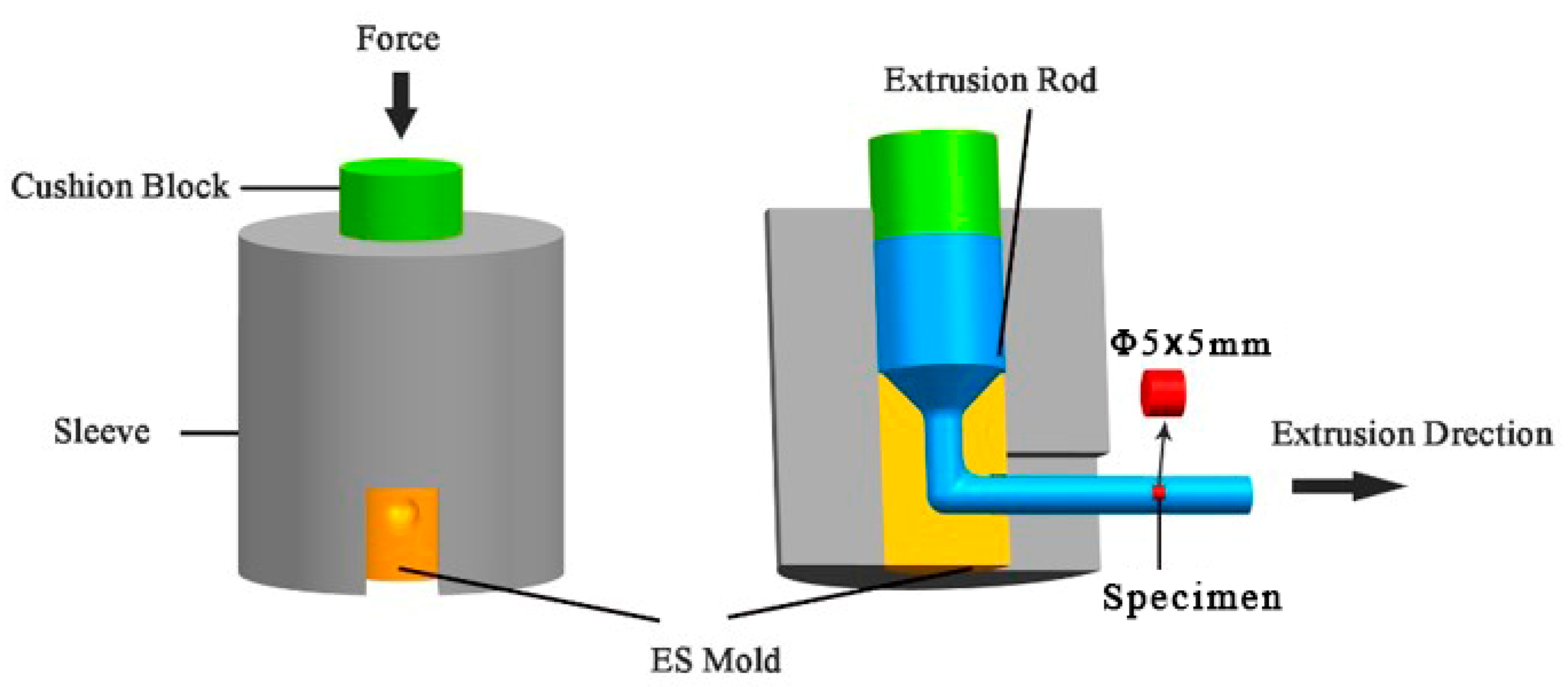

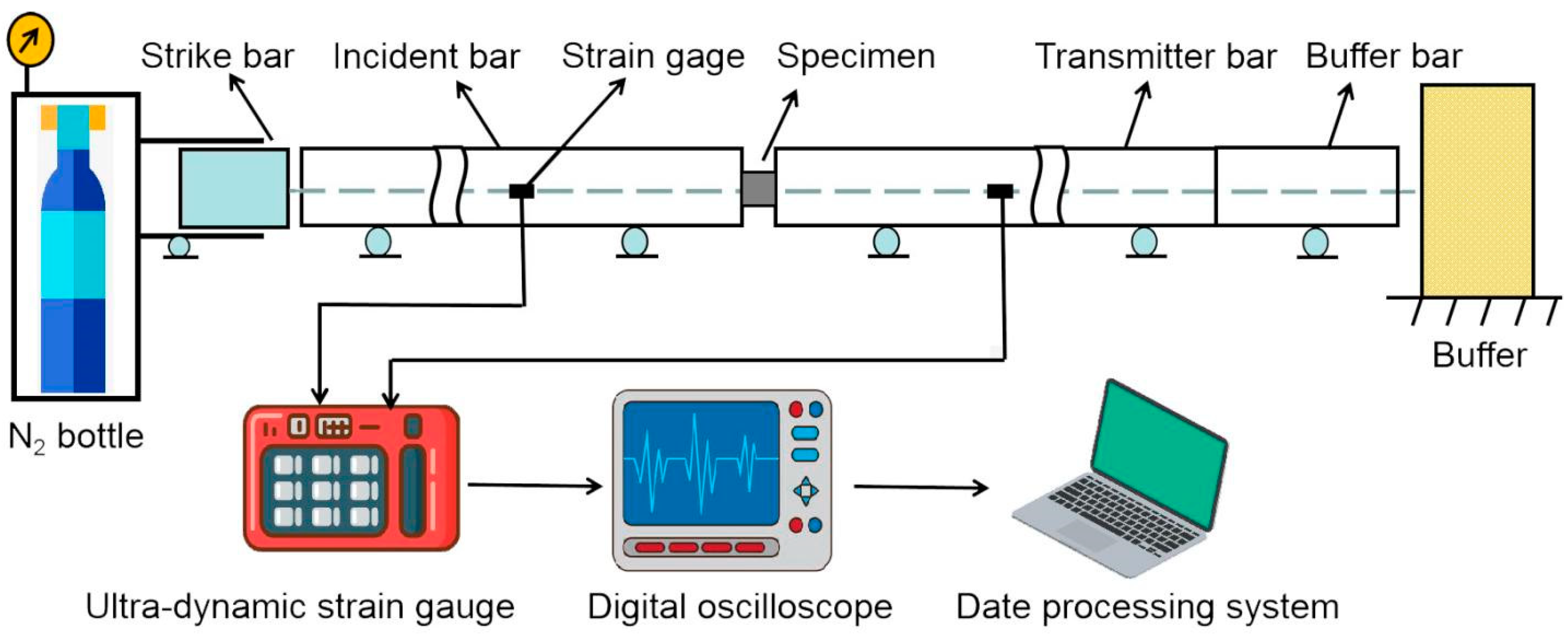


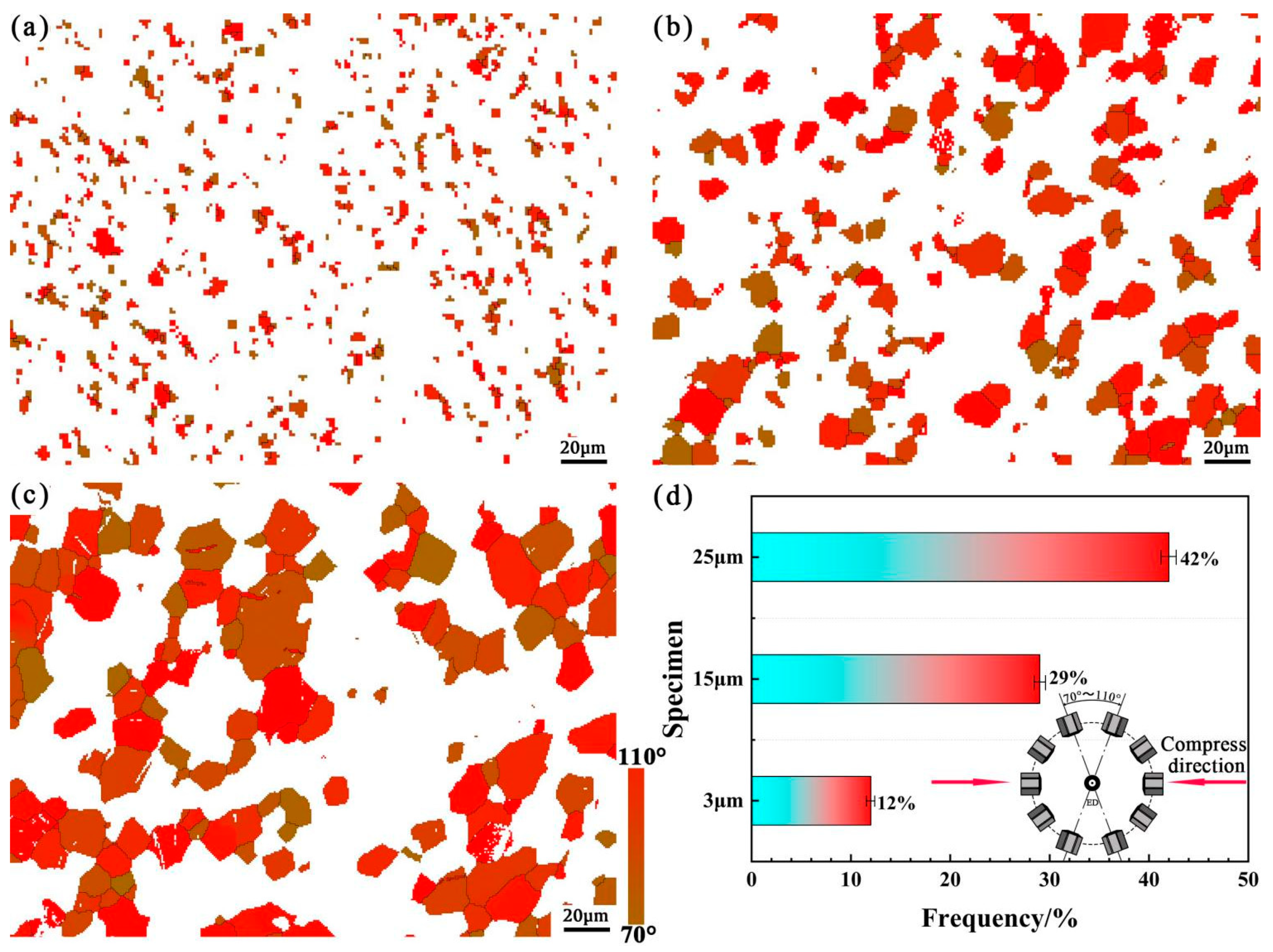
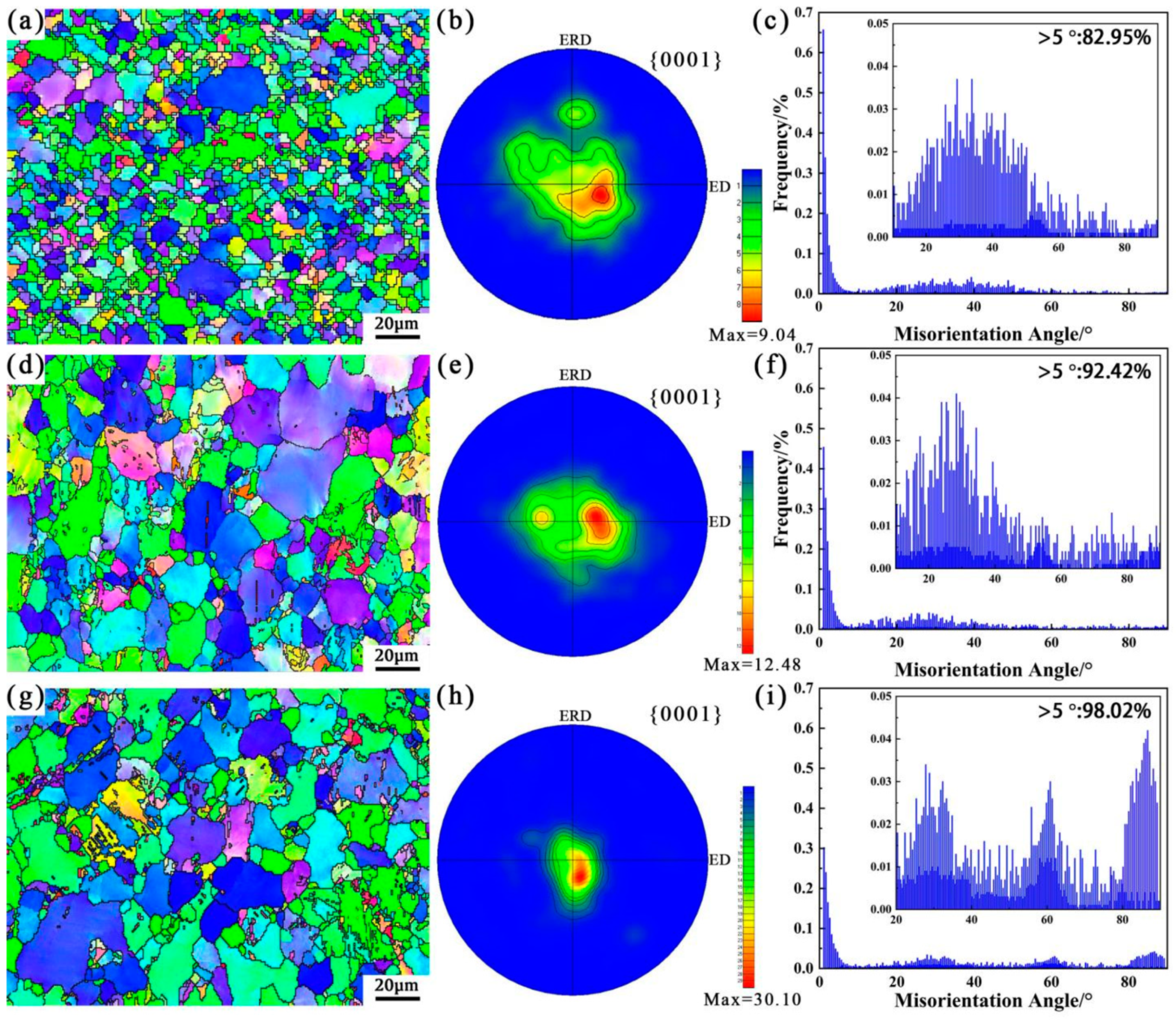
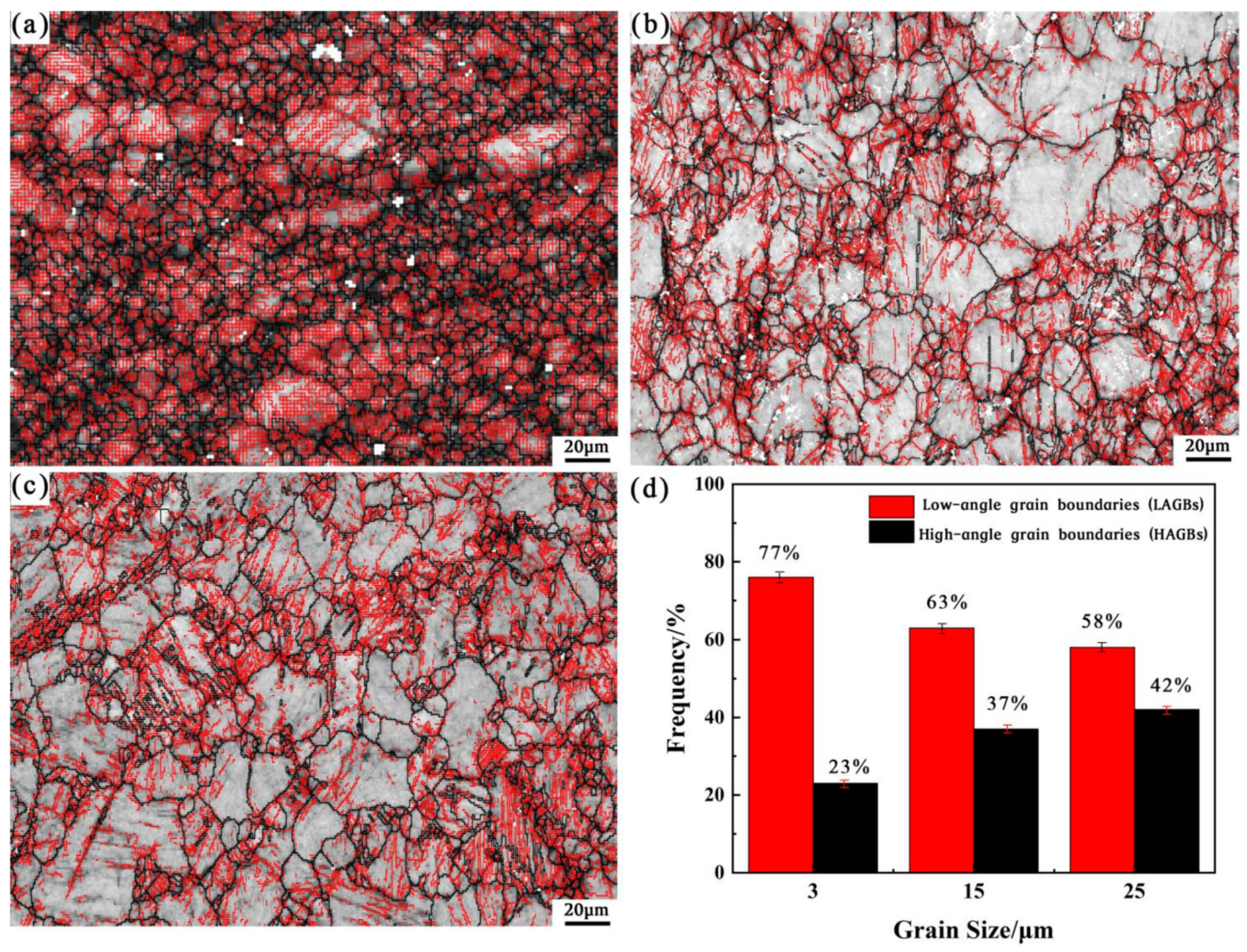
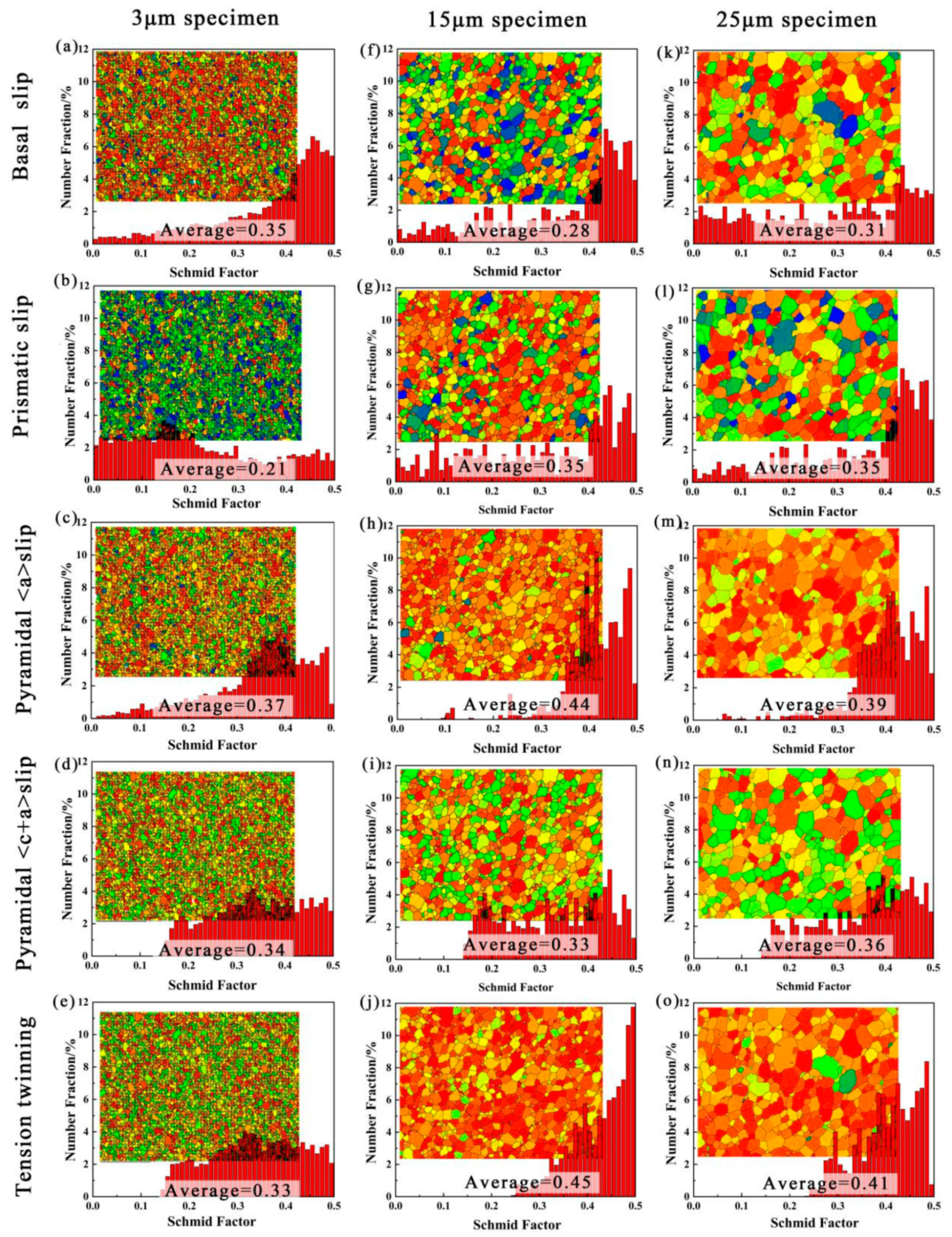
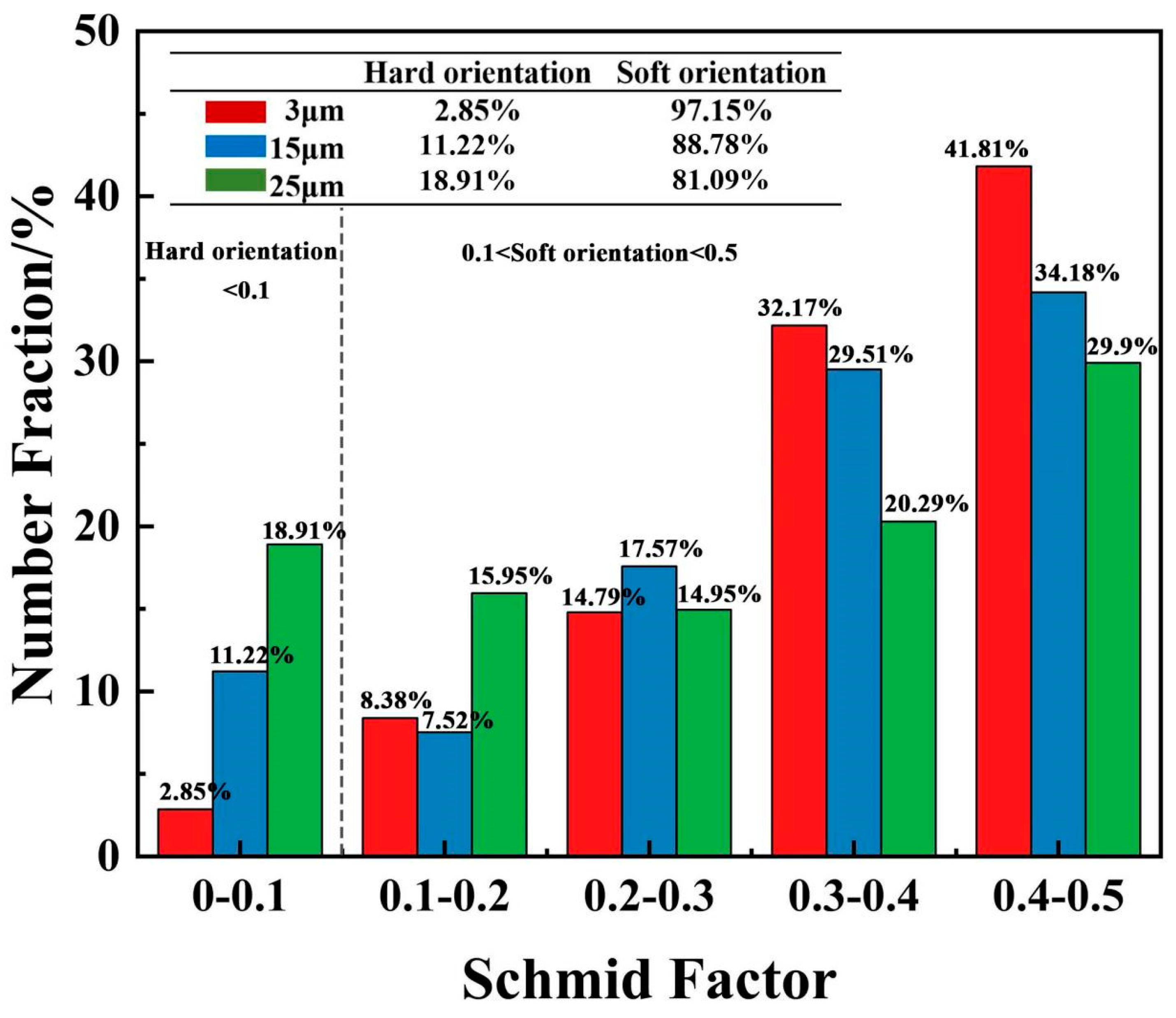
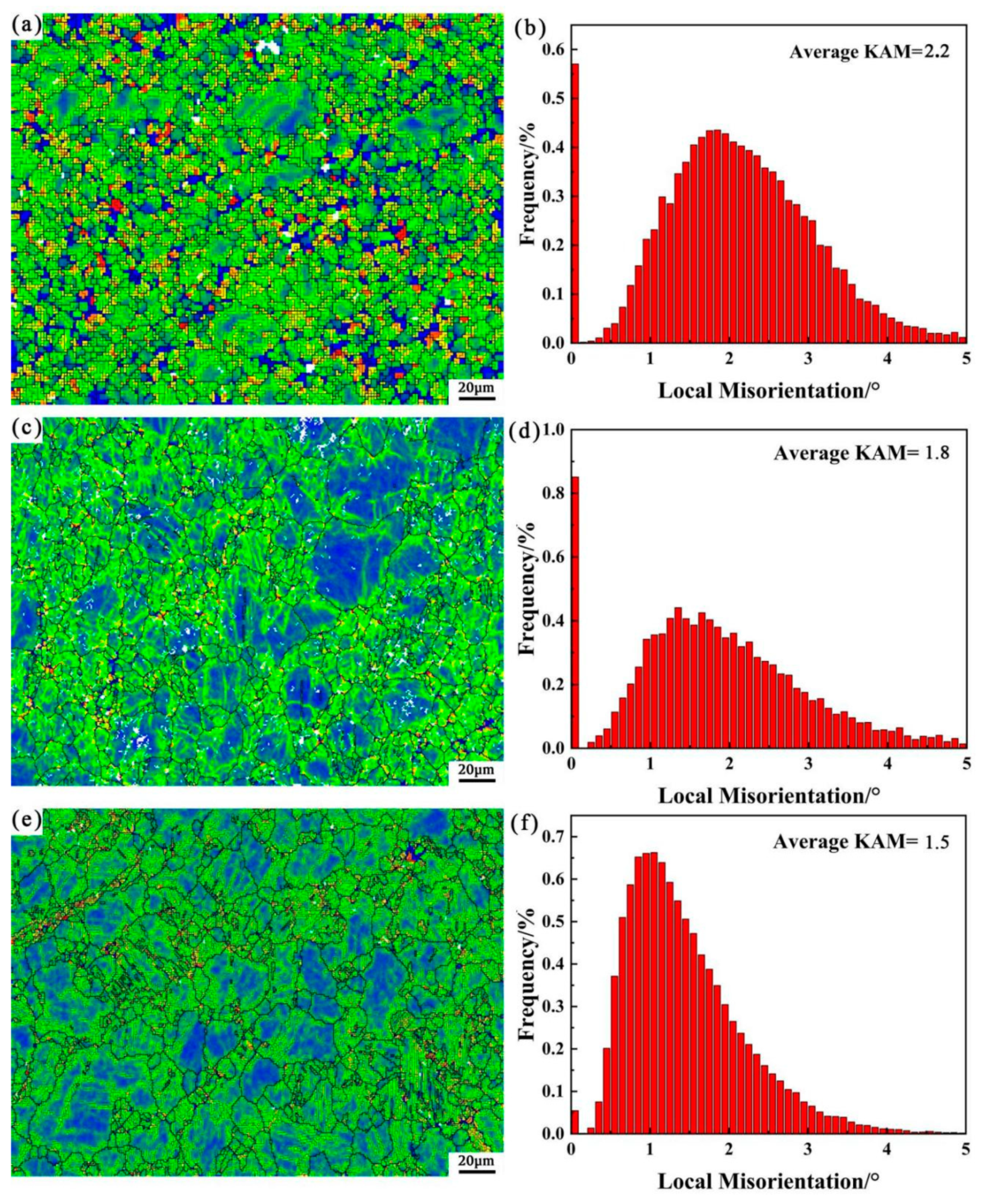
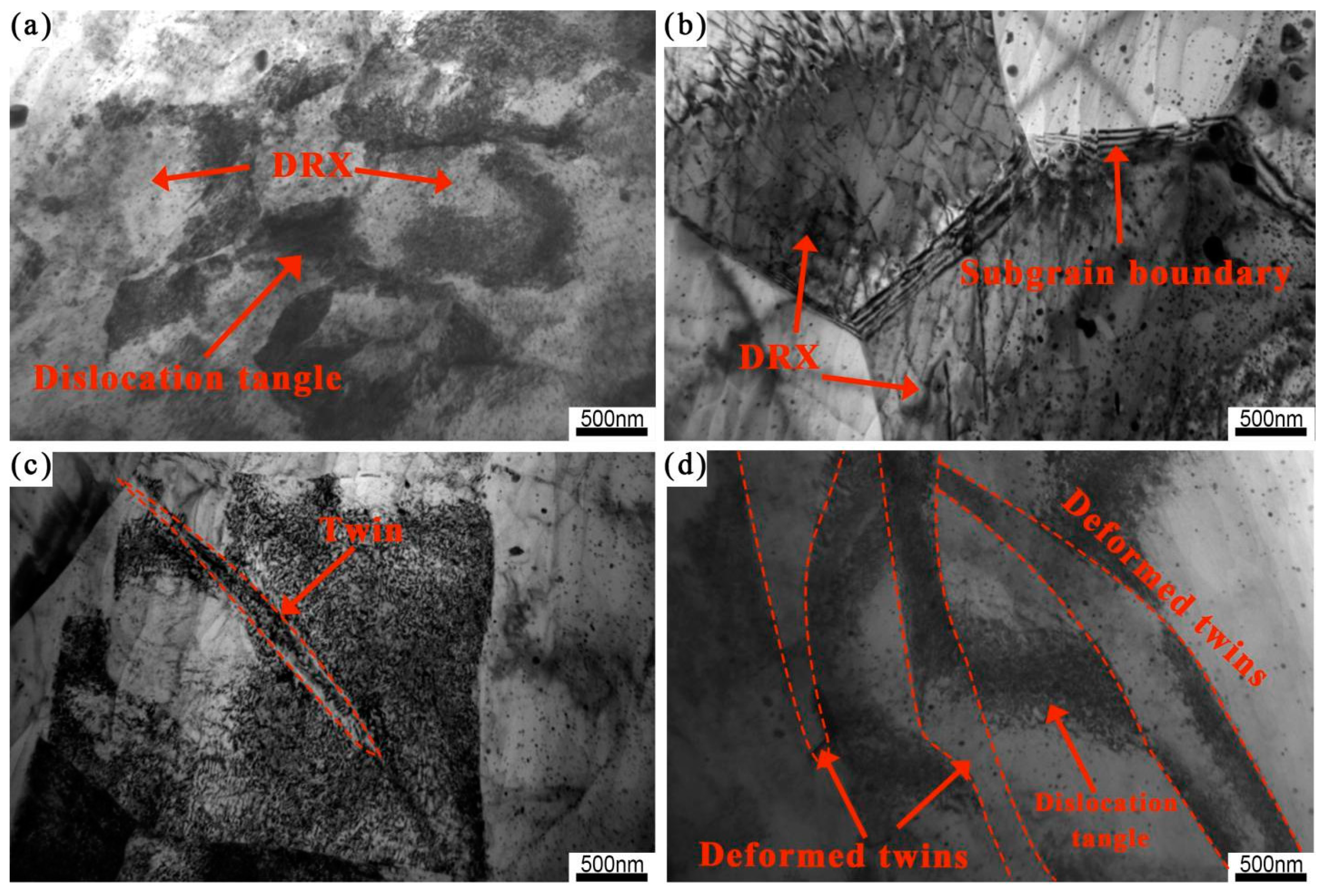
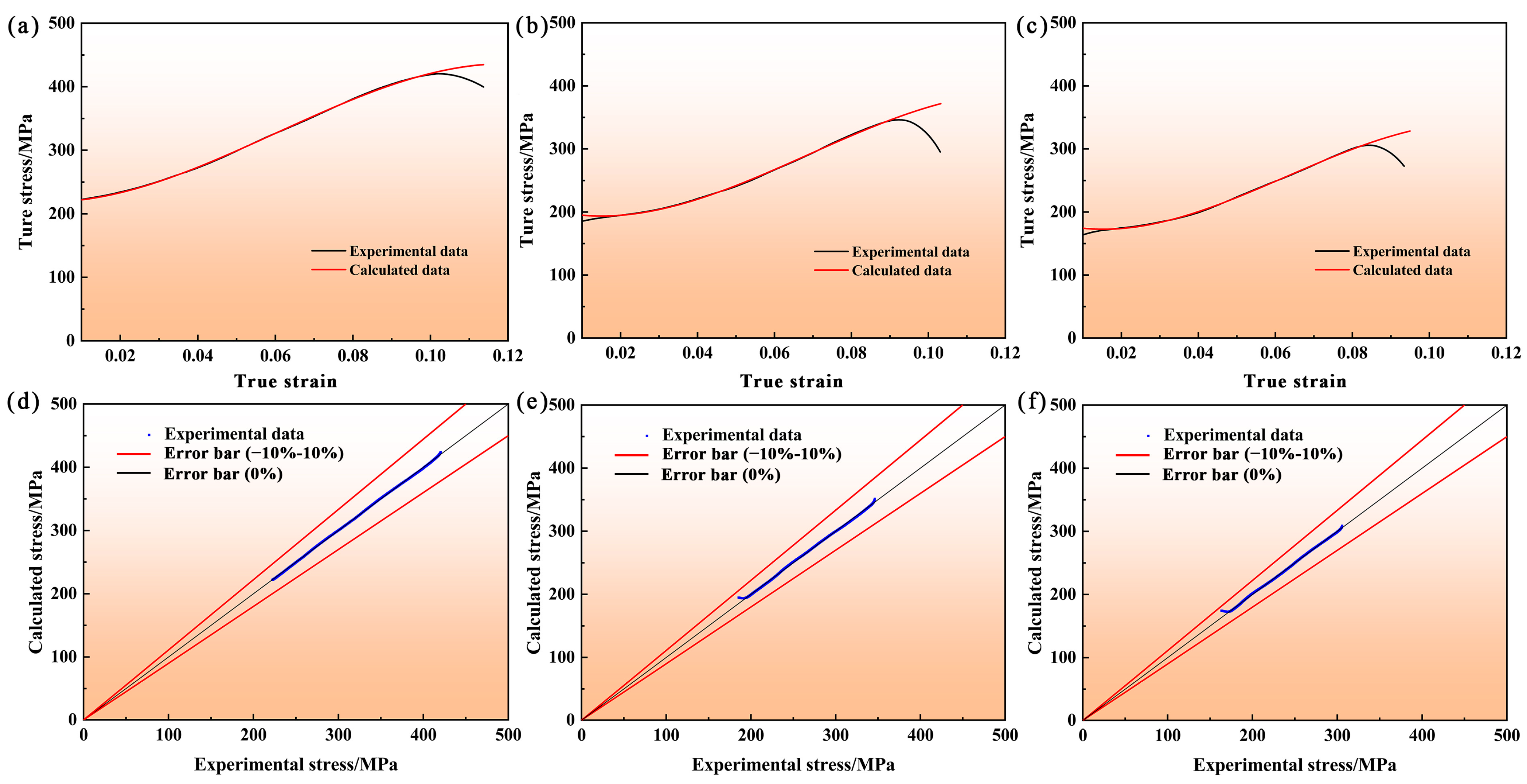
| Grain Size | Parameter Names | ||||
|---|---|---|---|---|---|
| A/MPa | B1/MPa | B2/MPa | B3/MPa | C | |
| 3 µm | 218.89 | −149.42 | 48,447.06 | −267,832.58 | 7.34 × 10−6 |
| 15 µm | 206.06 | −1730.11 | 64,634.08 | −313,013.63 | 9.89 × 10−6 |
| 25 µm | 187.05 | −1969.49 | 73,198.44 | −387,416.25 | 1.21 × 10−6 |
Disclaimer/Publisher’s Note: The statements, opinions and data contained in all publications are solely those of the individual author(s) and contributor(s) and not of MDPI and/or the editor(s). MDPI and/or the editor(s) disclaim responsibility for any injury to people or property resulting from any ideas, methods, instructions or products referred to in the content. |
© 2023 by the authors. Licensee MDPI, Basel, Switzerland. This article is an open access article distributed under the terms and conditions of the Creative Commons Attribution (CC BY) license (https://creativecommons.org/licenses/by/4.0/).
Share and Cite
Liu, X.; Mao, P.; Zhou, L.; Wang, X.; Wang, Z.; Wang, F.; Wei, Z.; Liu, Z. Effect of Grain Size on Dynamic Compression Behavior and Deformation Mechanism of ZK60 Magnesium Alloy. Metals 2023, 13, 314. https://doi.org/10.3390/met13020314
Liu X, Mao P, Zhou L, Wang X, Wang Z, Wang F, Wei Z, Liu Z. Effect of Grain Size on Dynamic Compression Behavior and Deformation Mechanism of ZK60 Magnesium Alloy. Metals. 2023; 13(2):314. https://doi.org/10.3390/met13020314
Chicago/Turabian StyleLiu, Xuanyu, Pingli Mao, Le Zhou, Xueting Wang, Zhi Wang, Feng Wang, Ziqi Wei, and Zheng Liu. 2023. "Effect of Grain Size on Dynamic Compression Behavior and Deformation Mechanism of ZK60 Magnesium Alloy" Metals 13, no. 2: 314. https://doi.org/10.3390/met13020314





